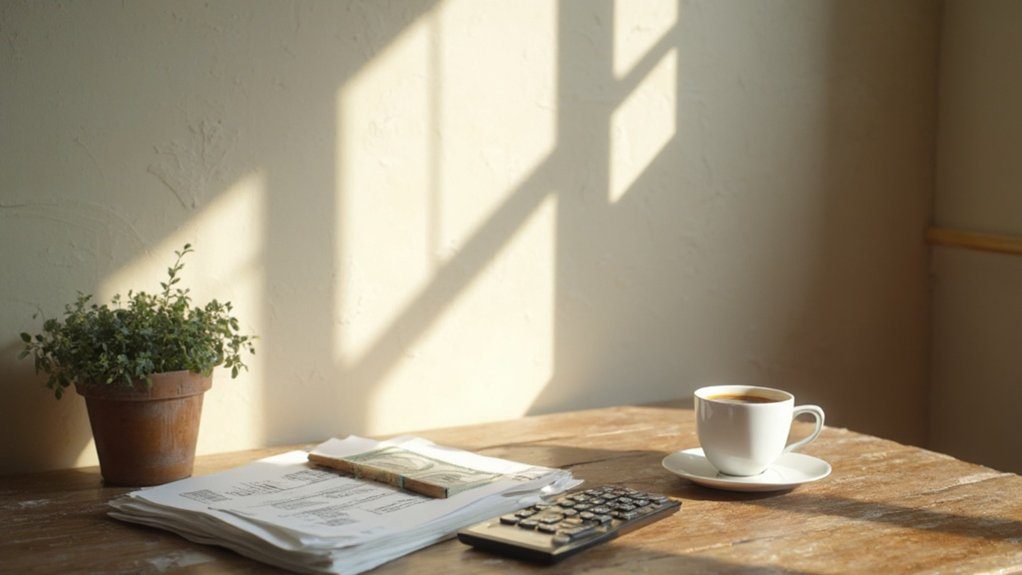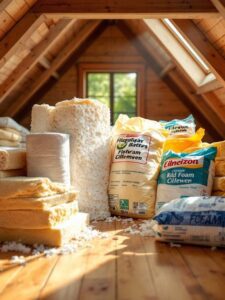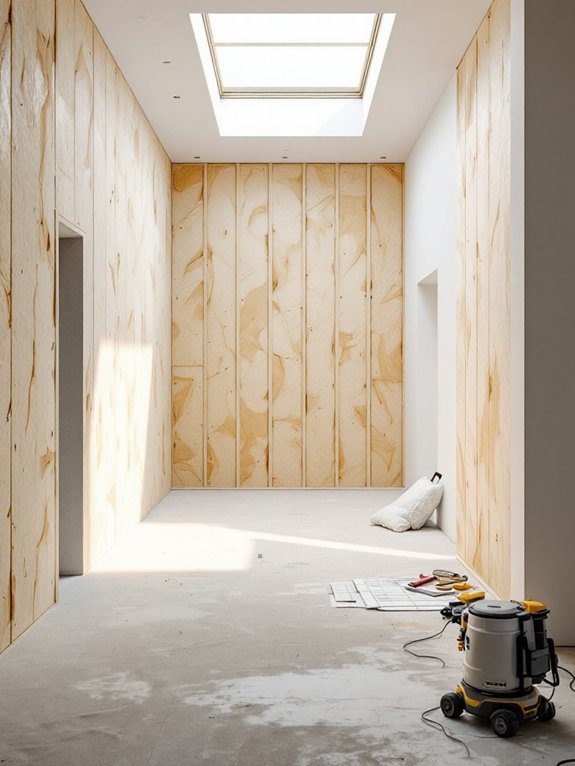You can finance external wall insulation through multiple complementary paths. Government grants offer up to £6,000 through the ECO scheme, while energy company funding covers 20-50% of costs. Home improvement loans start at 4% interest, and credit unions often beat bank rates by 1-2%. By combining these options with income-based incentives worth £1,000-£2,500, you'll greatly reduce your out-of-pocket expenses. Our thorough guide breaks down each financing strategy's eligibility requirements and benefits.
Key Takeaways
- Government grants through ECO schemes and Green Homes Grant can cover up to £11,000 of insulation costs for eligible homeowners.
- Home equity loans offer the lowest interest rates (4-8%) and longest repayment terms for financing external wall insulation.
- Energy company funding programs can cover 20-50% of costs, with additional incentives for low-income households and cold-climate zones.
- Combining multiple funding sources, including local authority assistance and energy company schemes, maximizes potential savings on installation costs.
- Investment payback occurs through 25-35% lower energy bills, increased property value, and reduced maintenance costs over subsequent years.
Understanding the Full Cost Breakdown of External Wall Insulation

Before committing to external wall insulation, you'll need to understand the complete cost structure, which typically ranges from $50 to $150 per square meter installed.
Like many homeowners investing in energy efficiency, you'll find that installation costs comprise roughly 40-50% of your total project budget, while materials make up 30-40%.
Your material choices greatly impact the overall expense. Standard EPS (expanded polystyrene) starts at $25 per square meter, while premium mineral wool can reach $45.
Additional costs include scaffolding rental ($15-25 per square meter), protective weatherproof rendering ($20-30 per square meter), and finishing materials ($10-15 per square meter).
Smart homeowners factor in supplementary expenses like window sill extensions, moving drainage pipes, and potential planning permissions, which typically add 10-15% to the final cost.
Government Grants and Support Schemes Available
While external wall insulation represents a significant investment, numerous government programs can offset 30-50% of your total costs.
The Energy Company Obligation (ECO) scheme provides up to £6,000 for eligible homeowners, while local authority assistance programs can contribute an additional £2,500-£4,000 through matched funding initiatives.
You'll find eco-friendly initiatives like the Green Homes Grant offering vouchers worth up to £5,000 for insulation projects.
If you're in a low-income household, you might qualify for enhanced support covering up to 75% of costs. Check your eligibility through the Simple Energy Advice service, which connects you with available grants in your area.
Remember to combine multiple funding sources – many homeowners successfully stack government grants with local council support to maximize their savings potential.
Home Improvement Loan Options and Interest Rates

If government grants don't cover your full insulation costs, several loan options can help finance the remaining amount.
Home equity loans typically offer the lowest interest rates, currently ranging from 4-8%, since they're secured by your property. You'll need at least 15-20% equity in your home to qualify.
Personal loans provide a faster alternative with less paperwork, though rates usually fall between 7-36% depending on your credit score. Many lenders offer specialized home improvement loans with terms from 2-7 years. You'll find better rates if your credit score exceeds 720.
Consider joining a credit union for member-exclusive rates that are often 1-2% lower than traditional banks.
Some installations companies also partner with lenders to offer promotional financing, but carefully review the terms as rates may increase after introductory periods.
Energy Company Funding and Incentive Programs
Many energy providers offer funding schemes that can cover 20-50% of external wall insulation costs through their Energy Company Obligation (ECO) programs.
You'll find these initiatives particularly valuable if you're looking to boost your home's energy efficiency while managing costs effectively.
To maximize your funding eligibility, consider these key program features:
- Income-based grants offering up to £6,000 for households earning under £31,000 annually
- Supplementary incentives worth £1,000-£2,500 for homes with EPC ratings below band C
- Regional bonus payments of 10-15% in designated cold-climate zones
- Combination options allowing you to stack multiple energy efficiency rebates
Check with your local energy supplier about their specific ECO4 scheme requirements.
Most programs require an approved installer assessment and proof of property ownership before funding approval.
Smart Budgeting Strategies for Wall Insulation Projects

Before committing to external wall insulation, you'll need to develop a detailed financial roadmap that accounts for both immediate costs and long-term savings. Start by gathering multiple contractor quotes and using budgeting tools to calculate your total project expenses, including materials, labor, and potential contingencies.
Set aside 10-15% of your projected costs for unexpected issues, and implement careful cost tracking throughout the project.
You'll want to break down expenses into monthly installments if you're self-financing, ensuring they align with your household income. Many homeowners like you find success by timing their projects with annual bonuses or tax returns.
Consider joining local homeowner groups to share cost-saving strategies and contractor recommendations, helping you make informed decisions while staying within your budget parameters.
Return on Investment: Long-term Savings and Property Value
Installing external wall insulation represents one of the most significant energy-efficiency investments you'll make in your home, with measurable returns visible within 5-7 years.
The financial benefits extend beyond immediate energy savings, contributing to long-term property appreciation and reduced maintenance costs.
- Energy bills typically decrease by 25-35% annually, translating to $300-500 savings per year
- Property value increases by 6-8% on average, as buyers prioritize energy-efficient homes
- Reduced carbon footprint leads to potential tax incentives and rebates worth $1,000-2,500
- Lower maintenance costs due to improved wall protection, saving $200-300 yearly
When you combine these returns, your initial investment of $8,000-12,000 can pay for itself through cumulative savings and increased property value, making external wall insulation a financially sound decision for your home's future.
Frequently Asked Questions
Can External Wall Insulation Be Installed During Winter Months?
You can install external wall insulation during winter, but you'll face specific challenges. Cold temperatures below 5°C affect adhesive curing, and wet conditions limit installation windows. Most contractors prefer warmer, drier months for ideal results.
How Long Does the Installation Process Typically Take to Complete?
Like assembling a giant puzzle, your installation timeline typically runs 1-2 weeks for an average home. The project duration depends on your property's size, but you'll join other homeowners enjoying better insulation in no time.
Will External Wall Insulation Affect My Home's Exterior Appearance?
Yes, it'll change your home's look, but you'll have multiple aesthetic considerations to choose from. You can select from various color options and finishes to match your neighborhood's style and maintain your property's value.
Do I Need Planning Permission to Install External Wall Insulation?
Don't jump the gun! You'll need planning permission in conservation areas or listed buildings, but 75% of standard homes don't require it. Check your local insulation regulations and building requirements before starting.
Can I Still Have Satellite Dishes and Cables After Installation?
Yes, you'll be able to keep your satellite dishes and cables. During installation, specialists will plan for cable management and can reinstall your satellite equipment. Just inform your contractor beforehand to guarantee proper mounting arrangements.
Conclusion
External wall insulation's ROI speaks volumes – you'll typically recoup your £8,000-£15,000 investment within 8-12 years through reduced energy bills. Like the ancient Roman insulators who used cork in their villas, you're making a timeless investment in efficiency. By combining modern financing options, available grants, and strategic timing of installations during warmer months, you'll maximize both immediate cost savings and long-term property value appreciation.








